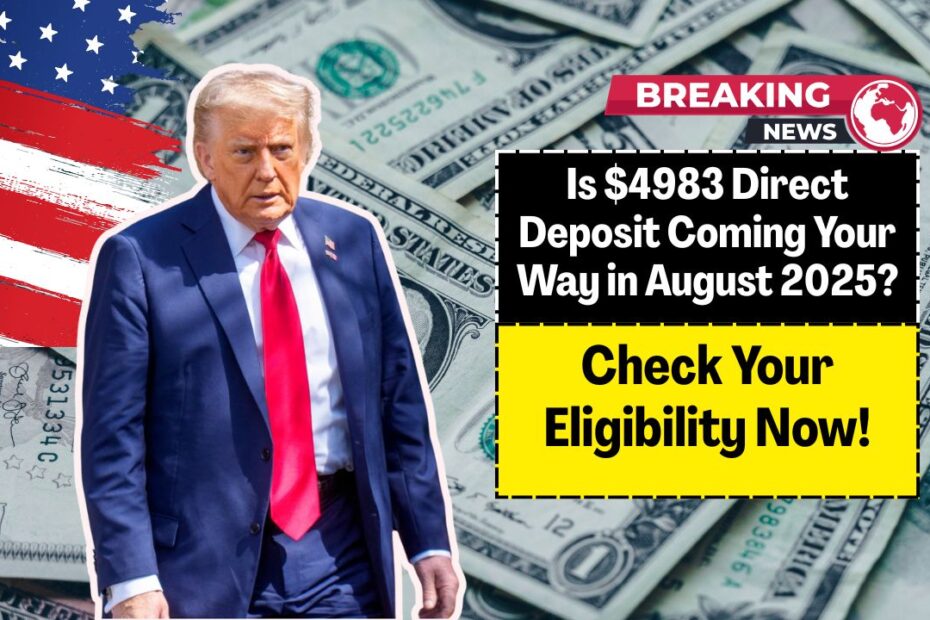In August 2025, many U.S. residents are in for a substantial boost, as the government rolls out a direct deposit of $4983 under new financial support initiatives. This initiative aims to provide much-needed relief to eligible individuals and families struggling with inflation, housing costs, and other financial hardships.
Whether you’ve heard about this direct deposit or not, it’s crucial to understand if you’re eligible to receive this payment, how to apply, and how it may impact your financial planning. In this article, we’ll break down everything you need to know about the $4983 direct deposit, eligibility criteria, and key government programs involved.
What Is the $4983 Direct Deposit?
The $4983 direct deposit is part of a broader initiative by the U.S. government designed to provide financial assistance to those most in need. This payment comes under stimulus programs, aimed at combating the rising cost of living, including housing costs, healthcare expenses, and childcare expenses.
This initiative is targeted at low-to-middle-income households, seniors, and those who are financially vulnerable, offering direct financial relief to reduce the strain caused by inflation.
Who Is Eligible for the $4983 Direct Deposit?
Eligibility for the $4983 direct deposit will be determined based on several factors, including your income, household size, and whether you qualify for specific government programs. Here’s a breakdown of the key factors:
1. Low-Income Households
If you fall under the poverty line or have an income below a specific threshold, you may qualify for this payment. The government’s target demographic includes households struggling to meet basic needs such as food, shelter, and utilities.
2. Seniors and Retirees
Seniors and retirees who depend on government assistance programs like Social Security, Supplemental Security Income (SSI), or Medicaid are also likely to receive the $4983 direct deposit. This payment serves as an additional financial buffer for those on fixed incomes.
3. Families with Dependent Children
Families who are eligible for Child Tax Credit (CTC) or Earned Income Tax Credit (EITC) may qualify for the direct deposit. With rising childcare and education costs, this financial aid can help reduce the strain on family budgets.
4. Social Security and Disability Recipients
If you receive Social Security or disability benefits, you might be eligible for the direct deposit to help cover the gap between income and the rising cost of living.
Key Government Programs That May Affect Your Eligibility
Several government programs are involved in determining eligibility for this $4983 direct deposit. Here are some of the most important ones:
1. Social Security Administration (SSA)
Social Security beneficiaries are a primary target group for this financial relief. If you’re currently receiving Social Security benefits or SSI, the payment may be directly deposited into your account as a top-up to your existing support.
2. Child Tax Credit (CTC)
Families with children may be eligible for Child Tax Credit (CTC), which provides financial assistance to parents for each qualifying child under 17 years old. If you’re already benefiting from this program, you might qualify for the direct deposit boost.
3. Supplemental Nutrition Assistance Program (SNAP)
If you’re receiving SNAP benefits, which assist with food purchasing for low-income families, this program might also make you eligible for the $4983 direct deposit, depending on your current financial situation.
4. Earned Income Tax Credit (EITC)
For working individuals and families, EITC offers tax credits to help supplement income. This initiative has been expanded in recent years, and if you’re eligible for this program, you could receive a direct deposit of up to $4983 in August 2025.
Also Checkout- $967 September Social Security Direct Payment Scheduled to Hit Accounts in 17 Days
How to Apply for the $4983 Direct Deposit
1. Check Eligibility
Before applying, make sure you meet the eligibility criteria set by the government programs. This will depend on your income, household size, and whether you’re currently receiving benefits through the Social Security Administration or other programs like CTC or EITC.
2. Apply Through Government Portals
If you’re not already enrolled in the required programs, you can apply through the IRS website, Social Security Administration, or state programs. Be sure to check the application deadlines and required documentation.
3. Confirm Bank Details
If you’ve already signed up for direct deposit, ensure your bank account information is up-to-date with the relevant agencies. If you are receiving other benefits via direct deposit, this payment should automatically be sent to your bank account.
Important Dates for the $4983 Direct Deposit
- Start Date: Payments will begin hitting accounts in August 2025, with exact dates varying depending on the payment method and your location.
- Deadlines: The deadline to apply for eligibility is typically mid-July 2025, so make sure to submit your application before then to guarantee payment.
The $4983 direct deposit coming in August 2025 is an important government initiative aimed at providing financial relief to individuals and families who need it most. If you meet the eligibility criteria outlined above, you could benefit from this payment, which will be a direct deposit into your account.
Ensure you stay informed about the specific dates and eligibility requirements, and apply on time to take full advantage of this support.
FAQs
How do I know if I am eligible for the $4983 direct deposit?
Eligibility depends on several factors, including your income, household size, and whether you receive benefits through programs like Social Security, EITC, or CTC.
When will the $4983 direct deposit be sent?
The direct deposit payments will begin in August 2025, with different dates depending on your location and payment method.
Do I need to apply for the $4983 direct deposit?
If you’re already receiving benefits through government programs like Social Security or EITC, you likely don’t need to apply. However, if you haven’t signed up for these programs, you may need to apply before the deadline in mid-July 2025.



